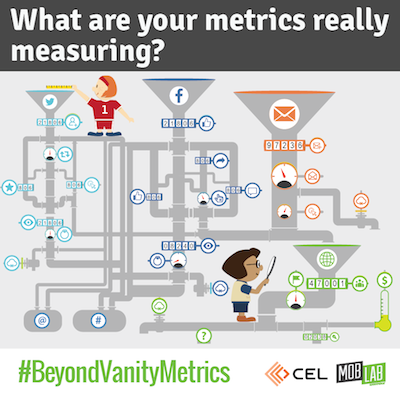One of the coolest things about digital communications is the real time feedback we get. Within minutes of posting to Facebook or sending an email, I can start assessing performance. This data can help us hone content and engagement strategies. But, it’s easy to get bogged down in tracking the wrong metrics.
For years, we at Resource Media have counseled clients to think beyond the “thud factor” in evaluating the effectiveness of traditional media outreach. Sheer volume of press coverage does not necessarily equal success. To really understand whether we’re advancing our agenda, we need to look deeper, and consider factors like story frames, messengers, and whether outlets covering our news are reaching target audiences.
The same is true with social media. It’s tempting to get caught up in vanity metrics like list size, Facebook likes, and Twitter followers. But these numbers don’t add up to meaningful engagement.
 The smart folks at Greenpeace Mobilisation Lab and Citizen Engagement Labs have just released a report, Beyond Vanity Metrics: Toward a Better Measurement of Member Engagement, that highlights the pitfalls of focusing on the wrong metrics, and the steps nonprofits can take to start measuring what matters.
The smart folks at Greenpeace Mobilisation Lab and Citizen Engagement Labs have just released a report, Beyond Vanity Metrics: Toward a Better Measurement of Member Engagement, that highlights the pitfalls of focusing on the wrong metrics, and the steps nonprofits can take to start measuring what matters.
Unsurprisingly, one of their core tips is to get clear on goals. You can’t determine whether Facebook is working for you if you haven’t identified the role you want Facebook to play in your campaign. Are you using it to drive online actions? Build your email list?
The report also urges a distinction between engagement and impact. Social sharing is nice, but does it help you win? Does it bring donations in the door? The whole idea is to have a data-informed digital strategy that flows directly from your organizational or campaign goals.
We know capacity for measurement and evaluation varies widely from organization to organization. Some of our partners have sophisticated digital dashboards and weekly metrics meetings, and some are just learning their way around Google Analytics.
If you’re just starting out, a simple spreadsheet is fine. Be sure to note trends and spikes in addition to just numbers. I believe the practice of measurement is as important as the numbers themselves. Make time to look at your social channels at least quarterly and reflect on what’s working and where there is room for improvement. Have digital staff check in with fundraising and program teams about their priorities and needs.
Want a thought partner as you’re setting goals or developing your evaluation tools? We can help!
Photos courtesy Opensource.com on Flickr, and Mobilisation Lab.
